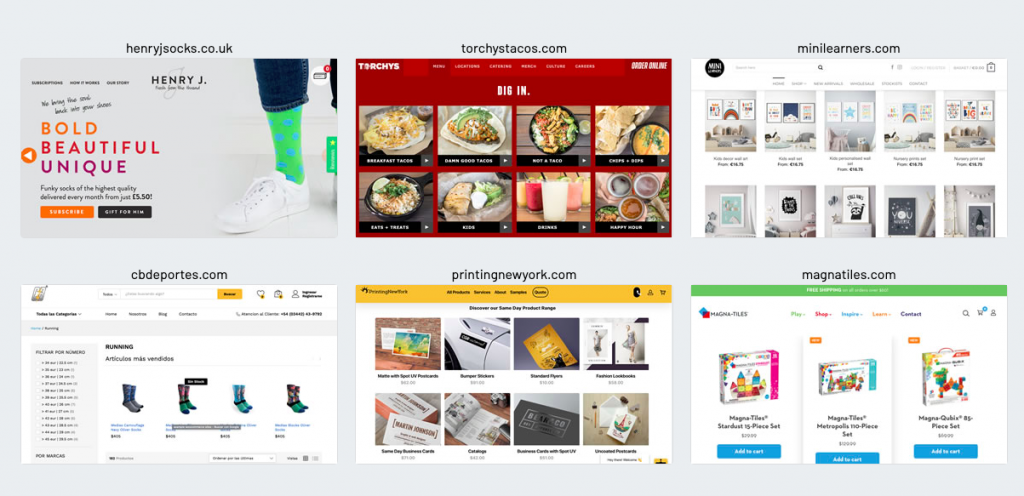- September 26, 2020
WooCommerce vs Shopify: Which one is best for your online store?
Reading Time: 12 minutesAre you thinking of starting your own online store? Not sure which one to use? Due to the increasing popularity and competition between WooCommerce vs Shopify, it is a bit difficult to know which of these two is the best to create a successful online store.
We have prepared this complete guide to help you pick the one that best suits your online business needs.
Let’s go through everything you need to know about WooCommerce vs. Shopify.
WooCommerce vs Shopify: The Most Used Platforms for E-commerce
The figures reveal that WooCommerce and Shopify are the most popular e-commerce platforms on the market.
If you have come this far, it is because you have strong doubts about which platform is best for your online store. Both WooCommerce and Shopify are the most famous and profitable.
Users normally prefer a set of functions, flexibility and simple prices when choosing an e-commerce platform.
However, it should be noted that each platform has its own set of complexities, advantages, and disadvantages.
So, in order to identify which of these two systems is the best for you, we shouldn’t just consider their popularity or prices. Let’s get into a deeper comparison to help you make the decision.
What is the best e-commerce platform? Before making a decision between WooCommerce vs Shopify, it’s important to know in detail how each platform works, what it has to offer, and what its main features and advantages are.
Many times we think we know exactly what we are looking for or what we need for our online store. But once we have a clearer idea of our options, we can determine what is actually best for our business.
What follows is a detailed and comparative analysis of WooCommerce vs Shopify, in order to give you the information you need to consider, along with our final recommendation.
How to choose an e-commerce platform
To choose the best platform it is important to factor in our long-term needs, not just our current ones.
There are certain technical qualities that we should take into account, such as:
Usability: you should consider whether it is easy to use, or if you will need the help of web design and development professionals.
Site loading time: ideally, an e-commerce website loads quickly, in order to increase our ranking within search engines, such as Google.
SEO tools: not all e-commerce platforms offer SEO tools. This is a must to support the growth of your business and to position your products and content.
Product options: it is important that the platform allows you to have product segmentation, lists, most popular products, on demand, among others. However, both WooCommerce and Shopify have the product options required.
Good technical support: it is essential to have 24-hour technical support in order to solve any eventuality.
Robust content and product manager: this aspect is related to usability, however, it is about obtaining greater functionalities and flexibility when publishing and managing the contents of your online store.
Plugins and integrations: a good e-commerce platform should put at your disposal a set of applications or tools that increase and enhance your online store, such as adding email marketing plugins, SEO plugins, and others.
Scalability and growth: think of your online store as a business partner helping you grow your sales. Some e-commerce platforms are not compatible with the growth of a business since they don’t grant it’s owners full control for personalization and scalability.
It is important to pick an alternative that allows you to have the control and freedom to implement all the changes that your business will need for its successful growth.
Mobile availability: this is essential, and it is so relevant that it has to be the first thing you look for in an e-commerce platform. This does not only mean that you can manage your online store through your mobile phone, but that your online store can be viewed by users on their own devices.
Remember that with the increase in the use of mobile phones, more and more users make their purchases through this medium.
With all of this in mind, let’s have a look at the two best options for your online store.
What is Shopify?

Shopify is a Canadian e-commerce platform that includes web hosting service, launched in 2004.
Its goal is to be a one-stop shop for moving your business online. Shopify provides its customers with everything they need for their business in one place, and this is why it is one of the most popular e-commerce platforms.
While it may seem like a pretty attractive option so far, especially if you are new to the world of e-commerce, Shopify has some limitations that cannot be ignored.
What are the advantages and disadvantages of Shopify?

This platform is characterized by allowing users to build an online store from scratch in a fairly simple and intuitive way. Thus, the skills that you will need to build your online store are almost nil.
However, if you want to take your online store further and make more complex customisations, you may need the help of a professional.
Shopify is a highly intuitive platform and is considered the benchmark against which all other platforms in the e-commerce industry today are compared.
Unfortunately, Shopify is not free, nor does it offer a free or even trial version. It is also not possible to use the service with a single upfront payment.
To use Shopify, you will have to pay a monthly plan along with a commission for each sale you make within the platform.
Shopify is the easiest platform to get started with because it guides you throughout the whole process to create your online store. With Shopify you can create your store without having any technical skills, avoiding any risk of mistakes.
Another benefit of using Shopify is that it is a proprietary platform. To put it simply, a proprietary platform is a platform that can only be worked on by its owner – Shopify. Your e-commerce store will be hosted on Shopify’s servers and they will be responsible for it.
If you choose Shopify, you will benefit from their services with unlimited storage. And, of course, you can add the domain name that you have purchased for your e-commerce store.
As for the SSL certificate, Shopify includes it in all their plans, so you will not have to worry about the security of your website.
What is WooCommerce?

Unlike Shopify, WooCommerce is not an e-commerce platform.
WooCommerce is actually an open-source WordPress plugin designed to add an online store to your main WordPress site.
All you have to do is install the WooCommerce plugin on your WordPress and you can have your store up and running shortly.
And the best thing about it: it’s free!
Currently, WooCommerce has accumulated 3.8 million users since its launch in 2011. Most of WooCommerce’s success is due to its ease of use, powerful functionalities, and unlimited customisation options.

But the most important thing is that it allows you to use WordPress, which is the most popular CMS in the world, to sell your products and services directly on your website.
What are the advantages and disadvantages of WooCommerce?
The first benefit of using this plugin is that if you are already familiar with WordPress, learning to use WooCommerce will be much easier.
The only downside is that you will need to install and maintain WooCommerce in WordPress yourself.
On the other hand, with WooCommerce you can pick your own web hosting service to host your online store, and alongside that, you have the option to choose the server specifications, such as its size, processor, bandwidth, storage, among others.
We suggest that you get a web hosting provider that will allow you to scale up your online store and trust that it will remain operational despite high traffic spikes. If you haven’t already, check out Neolo’s WordPress web hosting plans.
By now we can get an idea about why there is some rivalry between WooCommerce vs Shopify. But there’s still more to it.
WooCommerce vs Shopify: What do they have in common?
Both alternatives are completely designed and optimised to support your e-commerce activities. It is hard to find something in them that is not there to improve our business and sales.
On the other hand, these two e-commerce platforms also have extensions and basic tools to enhance and boost online sales. WooCommerce has plenty of add-ons and Shopify has applications to improve its performance.
However, they also both have well-defined differences, which allow us to better appreciate the advantages of one over the other, as we will see later.
How are Shopify and WooCommerce different from each other?
Even though the ultimate goal is the same, your successful online store, both platforms have notable differences that will become more evident in light of your business needs.
Although Shopify is older, WooCommerce’s success is down to offering more possibilities than its competitors.
In terms of content management, the big difference between WooCommerce and Shopify comes from the functionalities offered by a complete website.
Shopify is basically a window with different pages showcasing the products. On the other hand, WooCommerce is a powerful plugin with more functionalities to offer other than just displaying products and services.
If you want to create a customised website to showcase what you do and sell, your business news, and a blog, then WooCommerce is the best option. In order to start using WooCommerce, you will need a website running on WordPress on your favourite web hosting.
WooCommerce is a very versatile plugin, but this also means it might not be the easiest one to set up if you are a complete beginner. Shopify is easier to use, but it has more limitations as we will see in the following lines.
Technical comparisons between WooCommerce vs Shopify:
Next, we will analyse in detail their qualities and the technical specifications of each platform:
Usability
Shopify is easier to use, however WooCommerce is easy and faster to change and upgrade.
As we mentioned earlier, Shopify beats WooCommerce in the usability category. But this does not mean that the WordPress plugin is difficult to use. If you are only just starting out in the WordPress world, you may need a little help at the beginning.
The good news is that you will not need to know how to code to use Shopify or WooCommerce. Using both Shopify or WooCommerce is easy. And if you have any doubts on how to do things there are loads of forums, tutorials, videos and experts sharing their skills online to help you set up your online store.
SEO tools
WooCommerce has plenty of tools to improve your online store’s SEO. SEO optimisation is key when choosing the platform for your business. If you have better SEO, it is going to be easier for your clients to find your store and this will lead to more sales. If your online store is difficult to find, your chances for sales will potentially diminish.
What do you need to take into account to improve your SEO and what does each platform have to offer?
First of all, one of the key elements to improve the SEO of an e-commerce website is its loading speed. Since Shopify is a platform with dedicated servers, it works at an optimal loading speed.
On the other hand, if you choose to use WooCommerce, you will be able to do it on any equally fast web hosting service provider. Needless to say, we advise you to avoid poor quality web hosting providers. They may look like a cheaper option but you will lose sales with an unreliable and slow e-commerce site.
Both platforms offer the option to optimise images, which will improve the loading speed of your store. Additional features such as the use of title tags, alt tags, meta descriptions and product descriptions will also boost your SEO.
What other elements will improve my online store’s SEO?
Another factor that will improve your online store’s SEO is an SSL certificate. This certificate indicates to search engines that users can browse your website safely.
As we mentioned before, Shopify provides this certificate in all its plans, while with WooCommerce, you may have to pay for it when you get a web hosting plan. Luckily, most web hosting providers nowadays offer SSL certificates.
So far, Shopify might seem like the best option, but the truth is that it falls short of the functionality offered by WooCommerce, since it does not allow you to create content and fully customise it, as WooCommerce does.
Since WooCommerce is a WordPress plugin, you can create a blog with valuable content for your customers. Not only will a blog improve your SEO ranking, but it is a strategic marketing action that will attract more potential clients and increase your sales.
Customisation options
It is important to pay attention to the User interface (UI) as it creates the first and very lasting impression on your business when your visitors land on your website. Both alternatives offer interesting customisation options.
WooCommerce doesn’t have its own theme store. However, you can find cool (and highly functional) themes on sites like ThemeForest and Envato.
Shopify has its own template and theme store, with more than 180 different designs. Many of them are paid themes, but some are free (presently only 10). Most can be customised and modified without having to use any coding. Shopify’s premium themes cost between $140 – $180.
Even though it sounds like Shopify has a lot of options when it comes to themes, WooCommerce has overwhelmly more for you to choose from.
Lastly, remember to choose a lightweight and mobile responsive theme to ensure that your visitors have a smooth experience.
Plugins and extensions
Both WooCommerce and Shopify have extensions and applications to enhance your online store.
In this regard, both alternatives offer the features expected of a top-of-the-line e-commerce platform:
Create products
Importing a catalogue using CSV files
Display and description of products
Management of payment methods (we will talk about this shortly)
Management of orders, deliveries, clients, discount codes, vouchers, etc.
However, if you still need other tools, both platforms have supplementary tools to boost your online store. WooCommerce offers a large number of extensions and Shopify has a fairly large application store with almost 500 applications.
Pricing
The cost of WooCommerce will vary according to the needs of your online store, while Shopify offers plans with fixed prices.
Although the WooCommerce Plugin is free, the total cost of your online store may vary according to:
- The number of extensions that you add to your online store.
- Web hosting.
- Domain name.
- The payment options.
- Potentially having to pay for a programming expert to modify the code if needed.
Meanwhile, Shopify prices are a bit easier to calculate, as it offers different plans according to your needs:
$29 per month for Basic Shopify plan.
$79 per month for the Shopify plan (the standard plan).
$299 per month for the Advanced Shopify.
It should be noted that, although these prices must be paid per year, Shopify can become much more expensive in the long term, since you will also have to pay a commission for each of your sales.
Payment options
The payment options are one of the most complex and fundamental qualities when deciding on one of these platforms.
Both platforms offer over 100 payment getaways. Some are built-in and others can be added via integrations. Shopify, however, has major drawbacks for processing payments.
In order to process payments you will have to set up an account with a third-party organisation such as PayPal or Stripe.
But Shopify adds an additional fee of 2% that is charged to each transaction made through third-party payment gateways. This is on top of the transaction fees charged by the payment gateway.
However, you can also reduce the fee to 0.5% by upgrading to a more expensive plan (paying $299 per month for the Advanced Shopify plan).
The best way to process credit card payments is through Shopify Payments. This way you will only pay for the card processing fees and no additional fees.
On the other hand, WooCommerce has several extensions that you can use to add different payment options. A big plus for this platform is that it doesn’t charge transaction fees, making it more appealing if you expect big volumes of sales. Adding PayPal and credit/debit card payments via Stripe is free. WooCommerce has other payment options but it means you will have to pay (up to $79 per year) to use them.
In summary, both offer interesting alternatives, however, WooCommerce has a wider range of options, which we must seriously consider. Things to keep in mind are where you are based (some payment methods might be restricted to some countries) and how much is charged for transaction fees.
Scalability and growth
WooCommerce definitely offers more tools to scale your business and it’s a better option in the long run. As your business grows, you will need more resources to run your online store, and this is not just about traffic to your website.
Similarly, Shopify and WooCommerce can be scaled to handle a high volume of traffic and orders, but they do it differently.
First of all, Shopify only makes sure that all the technical aspects of your online store work correctly. So if your business starts to grow, you just have to upgrade to a higher plan. This means that you will have to invest more monthly to be able to accommodate the new requirements of your online business.
On the other hand, using WooCommerce will have higher upfront cost, however, this platform also offers you the possibility of maintaining control over all the installed tools. Therefore, you won’t have to overpay for resources you don’t need.
Shopify vs WooCommerce: Which one is better for an online store? Our verdict.
The winner, for us, is definitely WooCommerce.

Even if you are just getting started in this world of online sales, WooCommerce is an easy to use tool, and it can be mastered in no time. It is also the best tool in terms of cost and versatility.
Shopify is a platform that offers powerful benefits for beginners, but in the long run, especially if you aim to grow your sales, it will fall short and you will have to invest a lot more to cover an increasing in demand.
In regards to Shopify’s pricing, even after picking a plan you will have to factor in that transaction fees and any other add-ons (plugins and integrations) will increase its price.
Once your demand begins to grow (that’s the whole point of a successful online store, right?) your options will be limited to Shopify’s plans and upgrades.
Even if Shopify appears to be easier to use, and you will not have to install anything to set up your online store, you will never have full control over the resources used and full customisation. If you choose WooCommerce you will.
WooCommerce is by far one of the best ways to set up online stores and get into e-commerce for small and medium businesses. It is free to use, it’s open source code and compatible with WordPress. There are lots of themes, plugins and extensions for WooCommerce, you will be able to customise it fully and make it work best for your business. For all these reasons, we recommend that you use WooCommerce.
Don’t wait any longer. It’s time to start your successful online store!
For WooCommerce we recommend Neolo’s hosting

